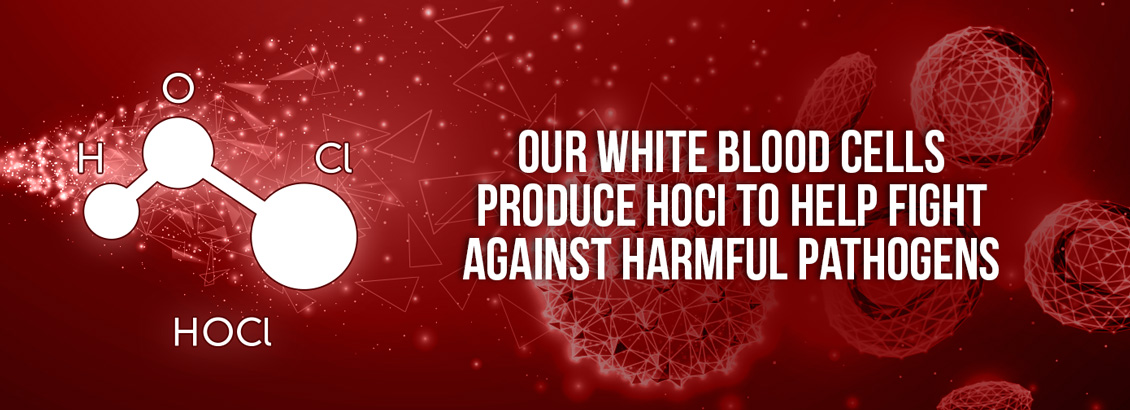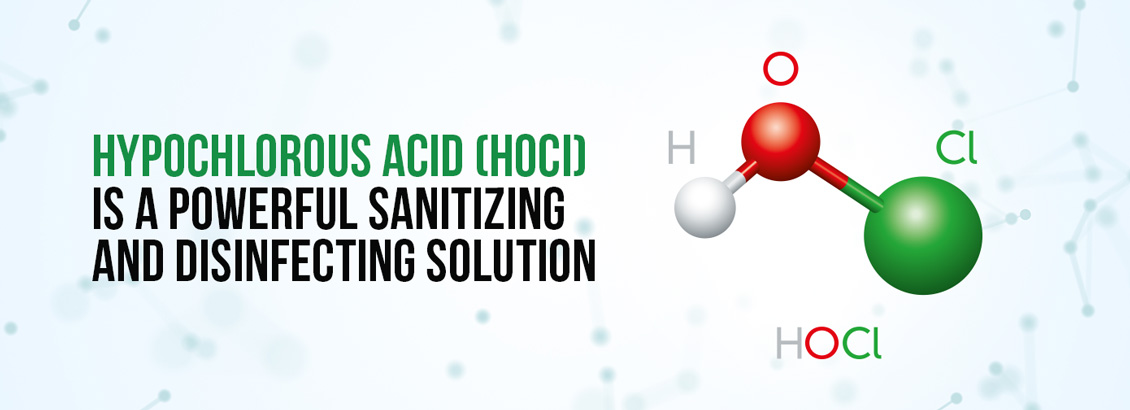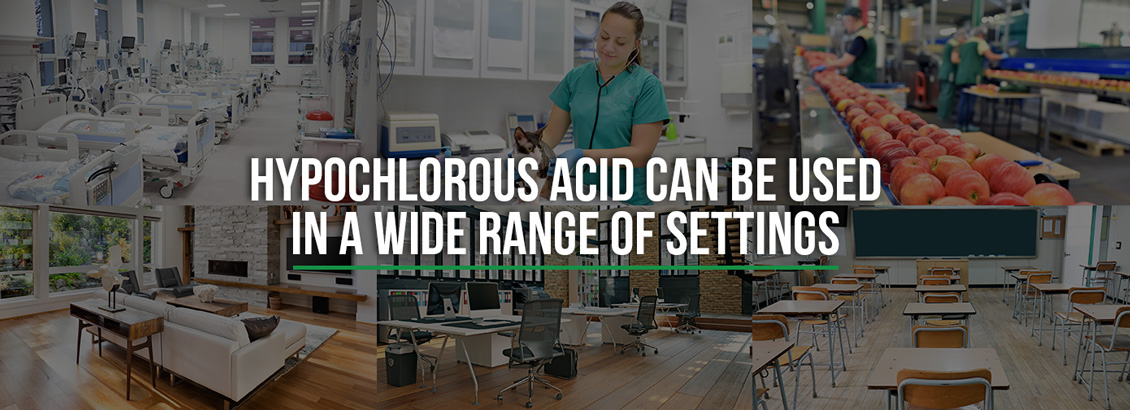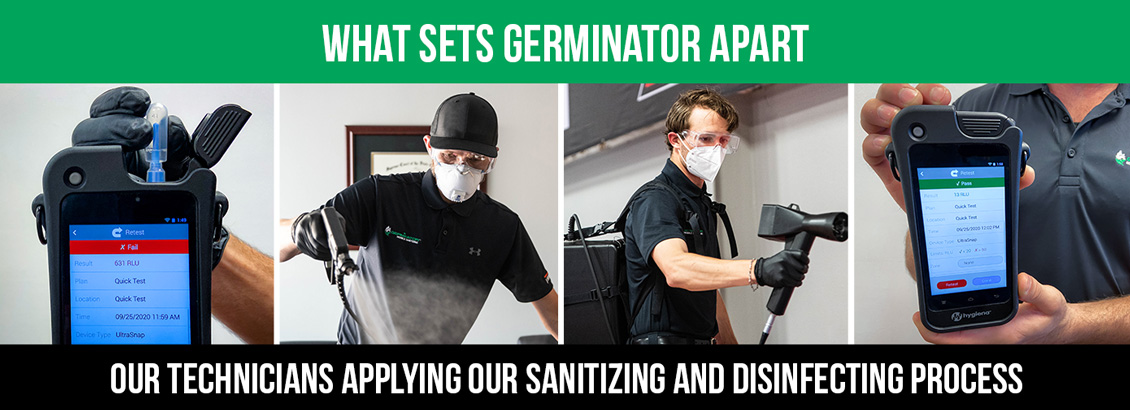What Is Hypochlorous Acid (HOCl)?
August 17, 2021
Did you know that hypochlorous acid (HOCl [lowercased "L"]) is a powerful sanitizing and disinfecting solution that also naturally occurs in our bodies? That's because our white blood cells produce HOCl to help fight against harmful pathogens.
White blood cells consist of five different types of cells: Neutrophils, eosinophils, basophils, monocytes, and lymphocytes. They produce
hypochlorous acid (US National Library of Medicine) during a process called
phagocytosis when we are injured to help our bodies fight off potential infections.

Our white blood cells sense harmful bacteria, viruses, and foreign substances, and once they find these invaders, they engulf them in what is called a phagosome. Inside the phagosome, a series of biochemical reactions produce hypochlorous acid intracellularly (within a cell), destroying the microorganism's cell walls and disrupting its vital internal proteins.
Now that we know how hypochlorous acid is produced in our bodies and used to fight off infections, how did we manage to manufacture hypochlorous acid outside our bodies?
How To Make Hypochlorous Acid
The most common method of manufacturing hypochlorous acid is by mixing salt minerals and water and introducing that solution into a process called
electrolysis, where the final result is
electrolyzed water. During electrolysis, the diluted saltwater solution is being passed through a low electrical charge that changes its chemical properties.
The salt is made up of chloride and sodium molecules (NaCl) and water molecules, as we all know is H2O. The chloride ions in the salt are negatively charged, while the sodium ions are positively charged. When the saltwater solution is exposed to a low electrical charge, the positive side of the charge electrochemically converts the chloride ion (Cl) and water molecules into hypochlorous acid (HOCl), and the sodium ion (Na) and water molecules turn into a byproduct called sodium hydroxide (NaOH).
That's how HOCl is made. It's a powerful oxidizing agent that has antimicrobial properties and is a part of our patent-pending process to sanitize and disinfect hard, non-porous surfaces.

HOCl is a novel solution for deodorizing, sanitizing, and disinfecting. Hypochlorous acid has actually been around for hundreds of years. While it isn't really that new, it's just now growing in popularity.
The History of HOCl
Hypochlorous acid has been around since 1834. It was discovered by a French chemist named Antoine Jérôme Balard.
Balard managed to create hypochlorous acid when he added diluted mercury oxide in water and mixed it inside a flask of chlorine gas. Using this process, hypochlorous acid was fairly easy to make, and the result also produced hydrochloric acid (HCL) as a byproduct. The problem, however, was that the HOCl solution resulting from his process wasn't stable.
It's only in recent years that we have managed to achieve cost-effective ways (like the one we explained in the section above) to produce stable HOCl solutions for commercial use in a variety of settings.
Where Can You Use HOCl?
As mentioned above, hypochlorous acid can be used in a wide range of settings and on a variety of objects and hard, non-porous surfaces to sanitize and disinfect against germs, viruses, and bacteria.
- Medical Facilities: It's ideal for medical equipment, surgical tools, blood pressure monitors, and even dialysis machines. HOCl can disinfect and sanitize everything from an ambulance to a patient care room. It meets the Association of Official Agricultural Chemists (AOAC) germicidal spray standards for Hospital Grade Disinfection. Hypochlorous acid is also on the EPA N List of products determined to meet the criteria for use against SARS-CoV-2, the virus that causes COVID-19.
- Veterinary Facilities: Because hypochlorous acid doesn't produce harsh fumes, it won't irritate an animal's nose. Furthermore, HOCl can be applied without worries if a pet were to lick itself in the treatment room.
Also, hypochlorous acid kills parvovirus, a contagious virus that mainly affects dogs. That's why HOCl is ideal for disinfecting kennels, pens, pet bowls, external surfaces of veterinary equipment, and much more.
- Food Processing Facilities/Hospitality Industry: HOCl can be applied on hard, non-porous surfaces that have been in contact with food. It can be used all the way from food processing plants and food storage areas to the places where food will be consumed, like restaurants, cafeterias, bars, grocery stores, and hospitality establishments.
In these settings, hypochlorous acid can effectively disinfect and help to prevent a wide range of foodborne germs and illnesses, including Salmonella enterica, E. coli, and norovirus.
- Homes and Offices: Hypochlorous acid is a simple solution for healthier homes and offices. Again, when used on hard, non-porous surfaces. It can be used to disinfect kitchens, bathrooms, living rooms, or in the case of offices, desks, chairs, keyboards, and more.
The kitchen in your home or office can be a hotspot for some of the common foodborne germs we mentioned in the previous section, but HOCl can help prevent an issue by protecting your surfaces.
In homes and offices, we also want to draw special attention to indoor air quality, which is greatly affected by non-living allergens such as dust mite matter, cockroach matter and debris, pet dander, and pollen particles. Hypochlorous acid can help break these non-living allergens down and improve indoor air quality for those with allergies.
- Educational Facilities: Hypochlorous acid is an easy and convenient disinfectant for schools and colleges, and yet, it's also gentle enough to use in nurseries and daycares.
HOCl is effective against influenza A (the common flu virus), rhinovirus (the common cold virus) and respiratory syncytial virus, which causes respiratory infections in infants.

The reason why hypochlorous acid is used in such a wide range of settings to sanitize and disinfect so many objects and surfaces is that it is "
80–200 times more effective than standard disinfecting procedures while being non-toxic to humans (US National Library of Health)."
Hypochlorous acid is really a top-of-the-line sanitizing, disinfecting, and deodorizing solution that we at Germinator have chosen to help us create more livable, touchable Germinator Zones for those to enjoy and feel protected in.
Germinator has over five years of experience researching different sanitizing and disinfecting methodologies. With the help of our
Scientific Advisory Board, we have chosen HOCl to help kill germs on surfaces, and our Shield solution helps prevent the growth of mold, mildew, algae, and odor-causing bacteria on surfaces as well.
As part of our patent-pending process, we offer ATP testing before and after our services to validate the effectiveness of our
surface sanitizing and disinfecting process.

Still, we at Germinator wanted to go above and beyond simply sanitizing and disinfecting surfaces. We wanted to provide 360 degrees of protection against the new world of germs.
That's why we are also offering the best sanitizing and disinfecting solutions for the
air you breathe as well as
body protection for when you're on the go.
Check out our
GERMINATOR Zone solutions page for more information about our surface, air, and body solutions. Call us at
855-NO-GERMZ (664-3769) or fill out the form here on our website to create your very own Germinator Zone and experience firsthand the power of our HOCl solution now!



